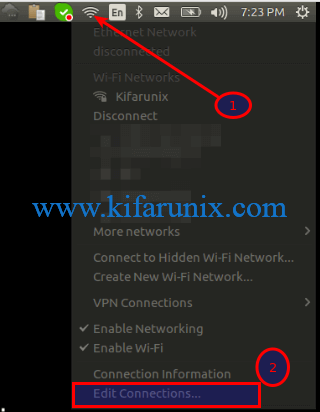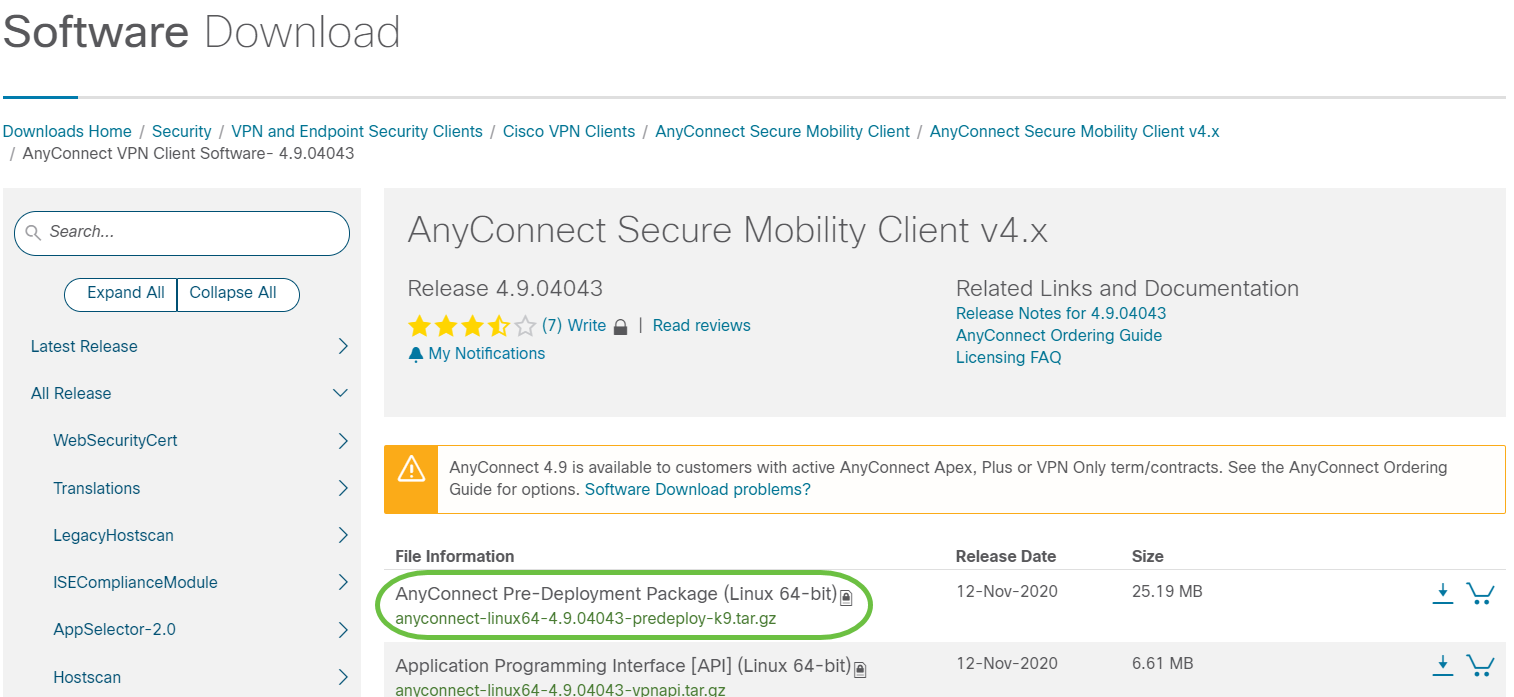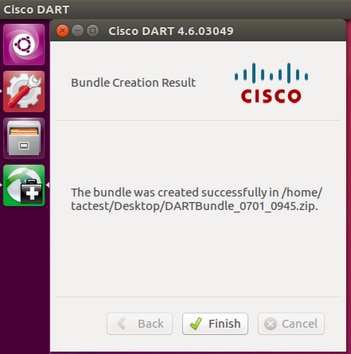- Install Cisco Anyconnect Ubuntu 20
- Cisco Anyconnect For Linux Ubuntu
- Ubuntu Cisco Anyconnect Vpn
- Cisco Anyconnect Ubuntu 2017
- Cisco Anyconnect Ubuntu
Ubuntu上安装anyconnect步骤 本文通过在win10上的virtual box上安装ubuntu的例子,说明anyconnect的安装过程。 下载ubuntu 1.
Objective
The objective of this article is to guide you through installing and using AnyConnect VPN Client v4.9.x on Ubuntu Desktop version 20.04 using the User Interface (UI).
I am using Cisco AnyConnect Mobility Client 4.5.02033 on Ubuntu 20.04. When I try to connect to the company's network it is working fine but as soon as I open any external website, (example: www.go. Nc -zc devnetsandbox-emea-gwy.cisco.com 20200 Connection to devnetsandbox-emea-gwy.cisco.com port 20200 tcp/. succeeded! Replacing the name and port from the connection detail email to confirm if its AnyConnect issue or DevNet gateway is unreachable. Or you could also look into using OpenConnect as VPN client. Jan 07, 2020 Cisco AnyConnect provides you the functionality of VPN and other features enabling the enterprise to secure its endpoints. It’s good idea to secure your system so here you will go through easy steps to easily Install Cisco AnyConnect on your Ubuntu / Debian / Fedora system. WSL2 and the Ubuntu 20.04 image just worked and ran smoothly and quickly. Combined it with the release version of Windows Terminal it was a real delight. I also went and grabbed Docker Desktop for Windows as it now has support for WSL2 as the underlying system.
Introduction
The Cisco AnyConnect Virtual Private Network (VPN) Mobility Client provides remote users with a secure VPN connection. It provides the benefits of a Cisco Secure Sockets Layer (SSL) VPN client and supports applications and functions unavailable to a browser-based SSL VPN connection. Commonly used by remote workers, AnyConnect VPN lets employees connect to the corporate network infrastructure as if they were physically at the office, even when they are not. This adds to the flexibility, mobility, and productivity of your workers. Cisco AnyConnect is compatible with Windows 7, 8, 8.1, and 10, Mac OS X 10.8 and later, and Linux Intel (x64).
Follow the steps in this article to install the Cisco AnyConnect VPN Mobility Client on a Linux computer using the User Interface (UI). In this article, Ubuntu version 20.04 is used.
Check out the article on Installing and Using AnyConnect on Ubuntu Desktop using the command line interface (CLI).
If you are using a Windows computer, click here to view an article on how to install AnyConnect on Windows.
If you are using a Mac computer, click here to view an article on how to install AnyConnect on Mac.
AnyConnect Software Version
- AnyConnect - v4.9.x (Download latest)
Table of Contents
Installing AnyConnect Secure Mobility Client v4.9.x
Step 1
Download the AnyConnect Pre-Deployment Package for Linux from Cisco Software Downloads.
The latest release at the time of publication was 4.9.04043.
Step 2
Navigate to the folder where you have downloaded the AnyConnect Client Package.
Step 3

The initial download is a tarball archive (*.TAR, several files packed into one), which must be extracted. To extract the files, right- click on the AnyConnect archive and choose Open with Archive Manager. Click Extract.
Step 4
You will see a notification once the extraction is completed. Click Close.
Step 5
Locate the vpn_install.sh file in the extracted folder.
To run the AnyConnect install script, open a Linux Terminal by pressing Ctrl+Alt+T on your keyboard.
Type ‘sudo ./vpn_install.sh’. This will begin the installation process. For more details on the ‘sudo’ command, click here.
Step 6
Accept the terms in the license agreement to complete the installation by typing ‘y’.
Using AnyConnect Secure Mobility Client v4.9.x
Step 1
To access the AnyConnect app, click on the start icon (appears as nine dots on the lower left corner). Choose the Cisco Anyconnect app.
Alternatively, press Super+A (Super key is the windows icon key) on your keyboard to bring up the search bar. Start typing 'Anyconnect' and the app will appear.
Step 2
Click on the AnyConnect Secure Mobility Client icon.
Step 3
Enter the IP Address or Hostname of your desired server followed by the port number.
For RV340 family, the default port number is 8443.
Step 4
Enter your Username and Password in the fields provided. Click Connect.
Step 5


Some connections may not be secure using a trusted SSL certificate. By default, AnyConnect Client will block connection attempts to these servers.
Uncheck Block connections to untrusted servers under Preferences to connect to these servers.
Step 6
As soon as the connection is established, the login Banner will appear. Click Accept.
You will also see notification that the Cisco AnyConnect Secure Mobility Client is Connected.

Conclusion
There you have it! You have now successfully learned the steps to install and use the Cisco AnyConnect Secure Mobility Client v4.9.x on Ubuntu Desktop using the UI.
Additional Resources
by Jeff Stern
(Note: There is also an alternative method of installing UCI VPN support without using the Cisco client, but using the built-in Debian/Ubuntu openconnect and openvpn drivers, should you find the below method does not work for you, or if you prefer to use open-source non-proprietary software.)
Introduction
OIT has a good general VPN-Linux page with instructions on setting up the Cisco AnyConnect VPN client software for Linux, but I got tripped up in a couple of places and thought I'd pass on some heads-ups for other Debian and Ubuntu users.
I originally wrote this 'How-To' for Ubuntu v10, and have updated it through v17.04. It should work for most or all Debian-derived distributions through 9.0 ('Stretch').
Please do write me to let me know how it went for you, and/or with any suggestions. I'd love to hear that it helped someone and/or any improvements that could be added.
Thanks to several for the help getting here.
Summary
Install Cisco Anyconnect Ubuntu 20
In the instructions below, I'll walk you through installing the Cisco VPN client on a Debian or Ubuntu system. When you're done, you'll have two commands available at the command-prompt, which you can run to connect to the campus VPN: 'vpn' (text mode) and 'vpnui' (graphical/windowing).
I used to also include instructions for getting VPN support to show up in the NetworkManager icon/applet in the system tray, for those who used a Gnome based desktop. I no longer do this, as it is too complicated these days to keep up with documenting the various desktop environments, and the changes (and unreliability) of NetworkManager. And it's not really necessary anyway. If you get it going for yourself, though, Kudos to You! :-)
Installing the Cisco AnyConnect client
- First, make sure you have the necessary Debian/Ubuntu support packages installed:
- Go to the UCI OIT Cisco Anyconnect/Linux instruction page.
- Download the 32 or 64 bit client as a .gz file.
- If you are usure whether you should use the 32 or 64 bit client: Most people are on 64-bit machines now. But if you are unsure, just run the uname command like this:As you can see from the above example, my machine has a 64-bit Intel (x86_64) based processor. If you see a '386' somewhere, then you are on a 32-bit machine.
- From the command prompt, go to the directory you saved the file to, and unpack it and run, just like the OIT instructions. Note you might have to put in some back-slashes because the download file apparently comes with spaces in the file name these days:
- If you get the following message at the end instead: it most likely means you did not install the two Ubuntu packages up in step 1, above.
- However, if you have installed those two packages, and are still getting this error, then user Steve Murphy wrote me (2015-12-7) with the tip that running the following did install enough dependent packages as to make it work for him:However, while this may help some users, this normally should not be necessary, and was not in my testing.
- However, if you have installed those two packages, and are still getting this error, then user Steve Murphy wrote me (2015-12-7) with the tip that running the following did install enough dependent packages as to make it work for him:However, while this may help some users, this normally should not be necessary, and was not in my testing.
- Now reload systemd, scanning for new or changed units:
- The vpn client should now have been installed on your system and the vpnagentd process started. You can verify this by looking at the active processes:
- During the installation, the vpnagentd daemon should now be set up to be started each time your system is booted. To verify:or
- Make command aliases to point to the vpn and vpnui commands:
- Also add these aliases to the end of your ~/.bashrc or ~/.bash_aliases file:(where you don't actually type the '^D': it means you hit Ctrl-D to finish).
If you want to edit your aliases file instead directly, you can run a simple editor, 'nano', which is usually available on Debian and Ubuntu systems:
Connecting and Disconnecting
Connecting (Graphical window)
Just run:And it should show 'vpn.uci.edu' already. Just click Connect.
Silicon integrated graphic. If you get an error message about an untrusted server or certificate.
.you can fix that following the instructions from Robert in the section NOTE 1 - Connect-error, below.
(By the way, depending on how the installation went, and whatever of the Linux desktop environments you are using (Gnome, Unity, KDE, Mate, Cinnamon, XFCE, etc.) you may also find that the vpnui graphical client now also appears somewhere in your Applications menu. But don't count on it! This is Linux, after all. :-) )
Connecting (via command-line)
- To start the client from a command-line prompt in a terminal window, using the alias you made above:
- At the VPN> prompt, type connect vpn.uci.edu and press Enter. (If you get an error message about an untrusted server or certificate, you can fix that following the instructions from Robert in the section NOTE 1 - Connect-error, below.) Otherwise, you should now see:If you do not see this, but get a connect error instead, please see NOTE 1 - Connect Error below.
- Ignore the message about entering your UCInetID and password, for now.
- Choose one of the choices by number and press return -- usually UCI or UCIFull. (See the differences in the Tunnels below.) For instance, for UCI, press 3 and hit Enter.
- Enter your UCInetID and password in the Username and Password boxes and press return.
- At the accept? [y/n]: prompt, type y and press Enter. You may get several notices the first time about the downloader performing update checks. At the end you should see a >> state: Connected message and a new VPN> prompt. You are now connected.
- Either leave the VPN> prompt open or if you want your terminal back just type quit at the VPN> prompt (the connection will remain active).
Connecting automatically via Command-line (w/o typing in your Username/Password)
I never (not yet?) figured out how to get the Cisco anyconnect software to run via script with command-line parameters sufficient for its running without having to type in your username (UCINetID) and password. I looked into the vpn command / executable supplied by Cisco (in the anyconnect-predeploy package) and running -h on it does not give much help.
Therefore, if you need something command-line and automated, I suggest you use the alternative method using open-source openvpn/openconnect software which I mentioned at the very top of this document. I include a way to do that in an automated way, and I find it works just as well and just as fast, but without having to install proprietary Cisco software. (This is the age of Ed Snowden's warning to us all, after all. :-/
NOTE 1 - Connect-error
In most cases I have seen, a connection is made. I have, however, seen the below error before only once. It was when the person was installing on a netbook (running Gnome) which was on campus and usingthe campus wifi system (though I don't know if those factors were the cause). It didn't matter if they answered y or n, they continued to get the error and be denied connection.
Cisco Anyconnect For Linux Ubuntu
Update 2015-12-6: 'Robert' wrote me with a solution to this:
- .the connect error.. can be resolved by sym-linking the cisco ca directory to the system ca directory as cisco only seems to include one root certificate by default. Or you can install the certificate chain from the VPN provider - sym-linking the system certs worked fine for me. Credit goes to: https://plus.google.com/+AndreasKotowicz/posts/2afhvvNZpE6
Thank you, Robert!
To disconnect (gui)
- Just click disconnect in the window
To disconnect (command-line)
- At the VPN> prompt, type disconnect and hit Enter.
Ubuntu Cisco Anyconnect Vpn
To exit (command-line)
- At the VPN> prompt, type quit and hit return.
De-installation / Removal
- Run Cisco's provided un-install script
- Optionally, also remove the cisco directory (if you don't need the .log files that were left behind):
Additional Hints, Tips, and Handling of Errors and Problems Contributed by Users
Several people have written in to me with some additional tips and solutions which I'll add here:
- From pierrechauffour:
- From zviad aburjania: This turned out to be a missing library fixable by:
- From zviad aburjania (2): (If that link no longer works, it is just recommended to start /opt/cisco/anyconnect/bin/vpnagentd first.)
- From pascal müller:
Pascal researched and found that the error, anyconnect was not able to establish a connection to the specified secure gateway is a known problem with Cisco clients before version 4, when these earlier clients are installed on Ubuntu 16.04+. The solution is either to downgrade your Ubuntu, or upgrade your Cisco client. At my university we have upgraded to offering version 4 (anyconnect-predeploy-linux-64-4.3.05017-k9.tar.gz), and this supposedly works with the newer Ubuntus. I did not myself test the new version 4 Anyconnect client with Ubuntus 15.x and 16.x. But I have tested it today (April 27 2017) with my Ubuntu 17.04 system, and it works great.
Contact / Feedback
Please email me to let me know how this process went for you, and/or with any suggestions for improvement on this page itself. Thanks.
Acknowledgements
Thanks to:
Cisco Anyconnect Ubuntu 2017
- Mike Iglesias and Sylvia Bass at UCI's OIT for for putting up the link to here from their VPN-Linux page.
- a page at Georgia Tech (now defunct), from which part of this page (the old Section 2, no longer included) was originally adapted.
- Joe Remenak for clear, concise feedback on some additional steps (1 and 11) necessary now for the newer 64-bit Ubuntus.
- Tom Distler, for the Tux/Cisco image at the top of this page, which I mooched from his page, How to connect Linux to a Cisco VPN using a PCF file.
- James Condie at UCI, who encountered multiple problems with the latest changes in the 4.3.05017 version of Cisco's install -- but patiently stuck with it -- thus encouraging me to update this page once again, and clarify a few additional things for newer Linux users.
- Philippe Moisan, who caught and reported an incompatibility with the find vpnagentd command above in Installation Step 8, for some versions of Linux, and offered also a fix: to put quotes around the '*vpnagentd*' which should work with all flavors of find.
Cisco Anyconnect Ubuntu
Last Updated Oct 30 2017
